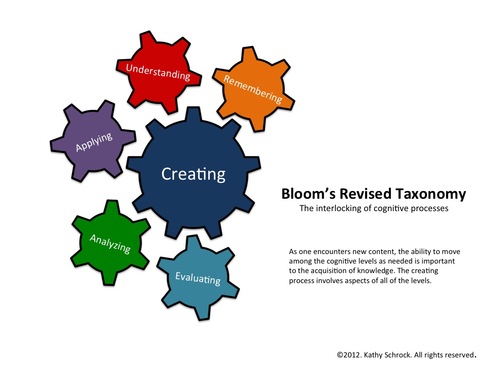Bloom’s New Taxonomy
I made some changes on Thursday night and when I got to class to do the presentation the changes were not there. I must have forgotten to save. I don’t know when I saw the new Bloom’s taxonomy, but it could have been for a diigo newsletter. For me it was a surprise to see that the known descriptors had change to verbs to indicate that the new learning model represented learning as an active activity. Evaluating is not on top anymore, instead creating is considered to be the highest order thinking skill. I noticed it, but didn’t know what it meant. I only knew that the creative process from my own experience and life of having two people in the arts. To me creating is not a concrete sequential activity. It is often a “messy” process, ideas and other processes coming in from all direction. The second model of Bloom’s taxonomy speaks to me much better. It reflects learning as active and how different thinking skills affect each other. For example at the beginning of learning the cog representing “remembering” or “knowledge” would be moving much harder than the other cogs and in term that particular cog will set other cogs in motion.
So the definition of what “creating” means put me on a quest. It seems that they have broken down “creating” into two types.- #1 is the “creating” artists do to express ideas in emotions in various artistic forms. The other, #2 is cognitive creativity which can be defined in various ways. Creative thinking can be arriving at alternative possibilities to a problem, coming up with useful ideas such as a product or solution and even a theory. The next cognitive creativity thinking skill could be evaluating and modifying exisiting ideas or exploring connections.
If “creating” or other HOTS (higher order thinking skills) are considered to be the most desirable skills students should be trying to attain, then how do we get there are educators or TLs? I think that it requires a change in attitude and behavior. We need to stop having students follow instructions when giving a topic to research. Taxonomy verbs such as “follow”, “describe”, “include” are restricting. We need to re-frame assignments that allow and foster exploration and curiosity. The inquiry model for research enables students to explore and to follow their curiosity.
A Foods teacher once told me and asked me, “I don’t know if I should be doing this project. The students don’t seem to be engaged?” Before becoming aware of the inquiry model and Bloom’s New Taxonomy, my comment, was to have her students use a different form of presentation. That is parallel to using technology to do the same thing. There is no change to the approach to learning.
I was also interested in the language that teachers use when giving assignments. As a TL who asks for a copy of a research assignment, I always try to come up with the ICT skills that could be incorporated into student research. Underneath the various skills I have listed the verbs and possible ICT skills. The bolded words are possible new terms which I think will need to incorporated to indicate a change in approach and behaviour.
Language is an important aspect of a library database. We have cataloging done for us and there are very few things we as librarians have to do, but we must make sure that it does reflect social justice. Cataloging is a subjective activity, someone make a decision about what subject headings to use and what not to use. It is up to the librarian to agree or disagree with the language/terms being used. When I first took over the library at my school, I looked over the collection and noticed that the subject headings for First Nations had Indians as a searchable subject term. The term “First Nations” was nowhere to be found. I was appalled, and changed every book and video’s subject heading to reflect the acceptable term for Aboriginal peoples. Librarians have to acknowledge that are responsible for social justice in their field.


Remembering (Can the student recall or remember information?)
recognize, list, describe, identify, retrieve, name, locate, find
Bulleting, marking key words, recalling, highlighting
ICT Skills
- Library database (creating a list of resources)
- social bookmarking (diigo)
- googling (adjusting reading levels, boolean terms)
- subscribed databases
Understanding (Can the student explain ideas or concepts?)
interpret, summarize, compare, explain, infer, discuss
blogging, journaling, twittering (beyond how are you?)
ICT Skills
- Mind mapping (mind meister, gantt)
- Google docs
- Blogger, Word Press
- Wikispaces
- Webquests
- Power point, Prezi, Glogster
Applying (Can the student use information in a new way?)
classify, show, examine, illustrate, use
uploading, collaborating, editing
ICT Skills
- skype
- smartboard
- webpage
Evaluating (Can the student distinguish between the parts?)
compare, contrast, explain, examine, categorize, investigate
validating information, analyzing, making judgements, breaking down information, understanding new relationships
- spreadsheet presentations (gliffy)
- web page (weebly)
- blog
- online newspapers (leaving a comment on an article)
Create (Can the student create a new product, show a point of view or a new way of viewing things?)
create, invent, compose, design, construct, imagine, plan
designing, inventing, constructing, planning, producing
ICT Skills
- Comic life
- iMovie
- Book Creator (iPad)
- Hyper Studio
- GoLive
- Story Kit
- Glogster
Further Information
Includes starter sheets for different ICT applications and rubrics

